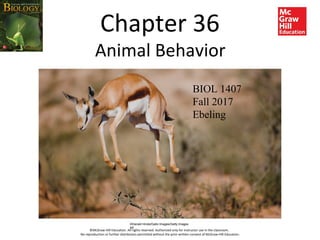
Behavior Fall 2017 blank pt 1 of 2 CEE
- 1. Chapter 36 Animal Behavior ©Gerald Hinde/Gallo Images/Getty Images RF ©McGraw-Hill Education. All rights reserved. Authorized only for instructor use in the classroom. No reproduction or further distribution permitted without the prior written consent of McGraw-Hill Education. BIOL 1407 Fall 2017 Ebeling
- 2. LEARNING OBJECTIVES • Describe how behavior can improve survival. • Describe how behavior can improve reproductive success. • Describe the benefits and drawbacks of living in a group. • Compare and contrast the behavioral adaptations of solitary and social animals. • Explain why male cuttlefish mimic females of the species.
- 3. What is behavior? ©James Hager/Robert Harding World Imagery/Getty Images Figure 36.1
- 6. Ethology
- 7. How can natural selection cause evolution of behaviors? VIDEO: This is how your brain grows
- 8. Examples of proximate and ultimate explanations of behavior Section 36.1 This figure summarizes some examples of proximate and ultimate explanations of behavior. Figure 36.27 Fruit Fly Courtship Mole Rat Nest Building Ground Squirrel Alarm Call Cuttlefish Female Mimicry Proximate cause (explains how behavior occurs) The fru gene guides development of motor neurons involved in courtship. Mole rats detect magnetic field lines and build nests (long underground tunnels) from north to south. Adult females use neural signals and muscles to produce a distinctive alarm call when they see a predator. Small males use neural signals and muscles to change their color and pull in their arms, appearing more like females. Ultimate cause (explains why behavior is adaptive) Courtship with a female of the same species leads to copulation and prevents mating with other species. Mole rats can orient themselves toward or away from the nest exit without visual stimuli. The alarm call signals danger to nearby ground squirrels, many of which are related to the calling female. Large males guard females. Small males that mimic females can slip past the guard and mate with the female.
- 9. Innate (Instinct) vs. Learned Behavior
- 11. VIDEO: Goose egg rolling
- 12. An example of a fixed action pattern Section 36.2 A classic example of a fixed action pattern comes from research done by Niko Tinbergen, one of the founders of modern ethology. Tinbergen found that any object that was red on the bottom was a stimulus for an aggressive response in stickleback fishes, even if the object did not resemble a fish. Since rival males have red undersides, being aggressive toward anything that resembles a rival male is adaptive. Figure 36.2 Stimulus Simple models with red undersides Accurate model without red Response Models are attacked Model is ignored
- 13. Fixed action patterns are genetically determined and inherited Section 36.2 Fruit fly copulation is another example of a fixed action pattern. Scientists have determined that a gene called fruitless is responsible for developing the motor responses of this behavior. Figure 36.3 1. Orienting: male detects female 2. Tapping: male taps female’s abdomen 3. Singing: male vibrates wing 4. Licking: male licks female’s abdomen 5. Attemptin g copulatio n 6. Copulatio n: male mates with female (b): Courtesy of Professor Daisuke Yamamoto, Tohoku University/JST-ERATO project
- 14. Learned behaviors Section 36.2 A learned behavior is altered based on experience. Examples of how learning affects behavior include: •imprinting [VIDEO Lorenz] •habituation •associative learning •observational learning •cognition Chimpanzees learn to use tools by watching other members of their social group. Figure 36.9 ©Dr Clive Bromhall/Oxford Scientific/Getty Images
- 15. Genes and the environment interact to determine behavior Section 36.2 Learning plays an important role in song development among young birds. Birds that never hear their normal song will develop an abnormal song. If a bird is exposed to a song of another species, the result is no better than if the birds heard no song at all. A genetic template therefore guides young birds to learn the correct song. Figure 36.6
- 16. Many behaviors improve survival Section 36.3 Behavioral ecology explores the survival value and evolution of behavior patterns. Most behavior can be linked to adaptations that increase survival, reproduction, or both. Keys to improving survival include •predator avoidance •finding resources or shelter •balancing foraging effort with the energy content of food Figure 36.12 ©Roy Toft/National Geographic/Getty Images
- 17. Optimal foraging theory Section 36.3 Optimal foraging theory predicts that an animal’s food- finding strategy should maximize the amount of energy collected per unit of time. For example, crows that eat snails must first break the shell. The bird picks up the snail, flies with it, and drops it on a rock. Figure 36.10
- 21. Section 36.3 • Camouflage • Deceptive markings • Defensive display • Warning coloration • Distraction display • “Selfish herds” Figure 36.12 Caterpillar: ©Jeff Lepore/Photographer's Choice/Getty Images; moth: ©Leroy Simon/Visuals Unlimited; praying mantis: ©Konrad Wothe/Minden Pictures Predator Avoidance Improves Survival
- 23. Section 36.3 The selfish herd hypothesis explains large schools of fish. School of fish: © Pixtal/AGE Fotostock/RF Predator Avoidance: selfish herd Bison herd
- 24. Many behaviors promote reproductive success Section 36.4 Most reproductive activities fall into the category of social behaviors, which are interactions among members of the same species. Social behaviors that promote reproductive success include courtship, mating, and parental care. Figure 36.15 (tail fanned): ©Corbis/SuperStock RF
Editor's Notes
- FIGURE 9-1 Mud pie for dinner? Humans show an aversion to eating dirt (and other substances from which we cannot extract nutrition).
- Section 9-1 Opener This chimpanzee has learned to use a twig as a tool to capture termites.
- FIGURE 9-4 (part 1) No learning required. Egg-retrieval behavior in geese and the aggressive behavior of male sticklebacks are fixed action patterns.
- FIGURE 9-7 Programmed to retrieve. The goose will retrieve any egg-like object outside its nest.
- FIGURE 9-3 Efficient eater. A shore crabs feed on a mussel.
- FIGURE 9-2 (part 2) Fatty and sweet. Across cultures, humans prefer sweet, but not too sweet, foods that are packed with fat.